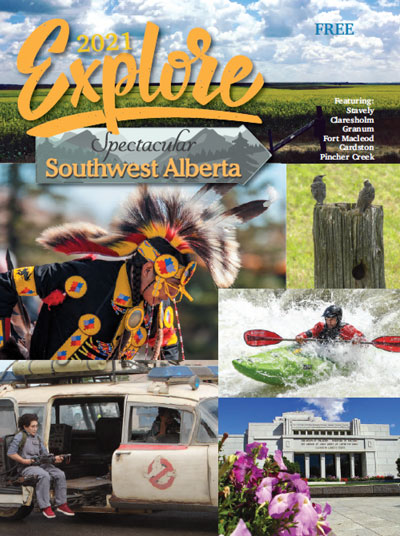Canada’s top elected official is the newest member of the Kainai Chieftanship.
Prime Minister Stephen Harper was given the Blackfoot name Ninayh’ poaksin, or Chief Speaker, on Monday at Stand Off.
“I am deeply grateful for the honour you have bestowed on me today,” Harper said. “It is an experience I will never forget, it is a bond of friendship that will inspire me in my service to you and to all Canadians.”
Harper joins select company in the Kainai Chieftanship, whose members include Pope John Paul II, Prince Charles and former prime ministers John Diefenbaker and Jean Chretien.
The Kainai Chieftanship is a bridge between cultures, and is a way of honouring people who have contributed significantly to the Blood Tribe.
“To be a member of the Kainai Chieftanship is to become part of a great tradition,” Harper said.
The Blood Tribe invited Harper to join the Kainai Chieftanship following the Prime Minister’s official apology in 2008 for the government’s role in the residential school system.
“Our view has always been forward-looking,” Blood Tribe Chief Charles Weasel Head said. “Rather than dwelling on negative experiences of the past, we utilize them to inform the present and assist us in planning and meeting the challenges of the future.”
Weasel Head said the Blood Tribe owes its stability to a tradition of strong leadership and cultural heritage.
The Blood Tribe also has a tradition of working with others, including the decision in 1877 to enter into a treaty with the British Crown.
“Kainai believed that through treaties their traditional way of life would be protected,” Weasel Head said. “And that relations with the newcomers would be peaceful and mutually beneficial.”
Today the Blood Tribe has about 11,000 members, most of whom live in the community. The economy is based on farming, ranching, oil and gas and small business.
Weasel Head said the Blood Tribe anticipates working with Harper’s majority government to address the systemic problems that affect First Nations across the country.
“We are hopeful for the future,” Weasel Head said.
That hope is based in part on Harper’s apology for the residential schools.
“I know that the Blood Tribe was deeply affected by that, and I’m glad to hear the government’s policy was so well received among you,” Harper told his audience. “But as you know the work of healing and reconciliation continues and we must also continue our work together to improve the quality of Canada’s First Nations and aboriginal peoples.”
Blood Tribe elder Wayne Plume gave Harper the Blackfoot name Ninayh’ poaksin.
Master Corporal Melissa Whitegrass was chosen for the ceremonial “capture” of Harper as a new member of the Kainai Chieftanship.
Whitegrass, who as a member of the 18th Air Defence Regiment in the Royal Canadian Artillery, was wounded in 2010 while serving in Afghanistan.
Elder Pete Standing Alone conducted the headdress ceremony.
“It’s a great honour to transfer the headdress,” Standing Alone said.
Harper looked to Blackfoot Chief Red Crow for an understanding of what it means to be a member of the chieftanship.
“He was a strong leader in a difficult time of transition,” Harper said of Red Crow. “He fostered new economic opportunities for his people, while defending their religion. He instilled in them a fierce and famous pride in their identity.”
“I am pleased to see that this tradition continues to flourish among the Kainai,” Harper added. “It is an inspiration not only to everyone gathered here today, it is an inspiration to all Canadians, and it is an inspiration to me, as prime minister.”
Harper also spoke of Senator James Gladstone, a member of the Blood Tribe who was the first aboriginal to sit in Parliament.
“This was a significant achievement of course, but it came after many years of hard work and accomplishment on Gladstone’s part,” Harper said. “It was not a mere symbol or a cap on his career. It was a new opportunity to keep working for the peoples and causes he championed.”
Harper promised his government will follow Gladstone’s lead as it works on behalf of all First Nations.
Harper said while the Blood Tribe’s culture and identity is unique, all Canadians can identify with its values and aspirations.
Harper said the Blood Tribe’s pride, self-sufficiency and a tradition of working with others is a model for the rest of Canada.
“These are things our government hopes to foster not only in our relationship with First Nations and aboriginal people, but in everything we do in our service to Canadians,” Harper said.
Both Harper and Weasel Head referred to the new self-government agreement that is being developed.
“This is a positive thing for which everyone involved deserves great credit,” Harper said.
Harper pointed out that in the last federal election seven First Nations members were elected to Parliament — the most in Canada’s history. Five of those people are government MPs, and two are in cabinet.
“This is truly a great accomplishment which we can all celebrate,” Harper said. “Aboriginal voices are increasingly strong, taking a greater part in the decisions which affect us all. This is a good thing not only for aboriginal Canadians but for all Canadians who benefit from the wisdom and insight of the first inhabitants of this land.”






